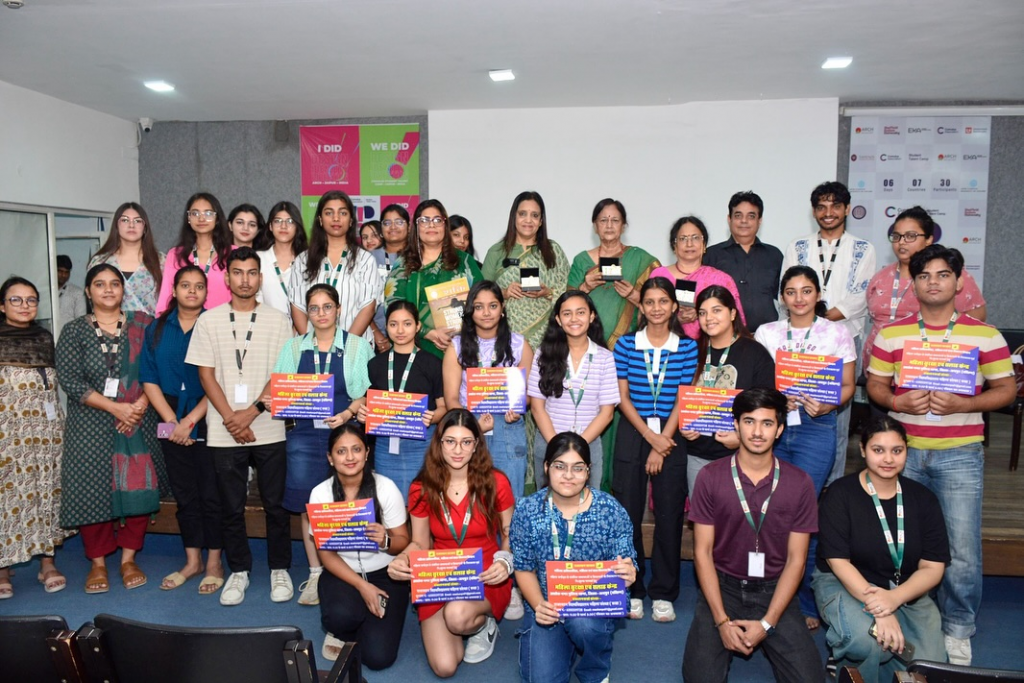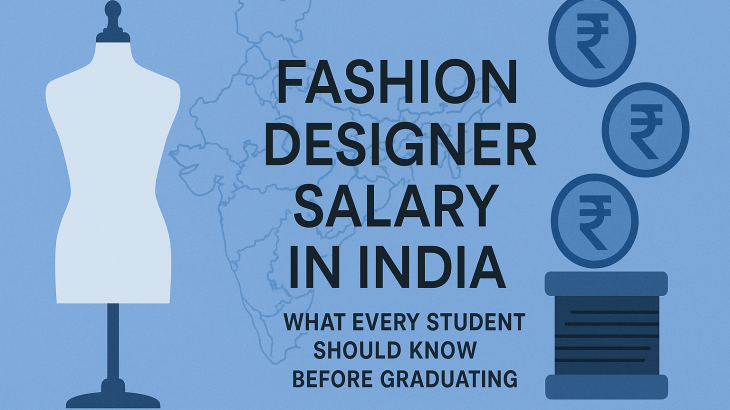The world of fashion is full of allure, glamorous runways, Insta-worthy studios, and the thrill of watching your vision come to life. But behind the sparkle lies a very real question for every aspiring designer: how much do fashion designers actually earn in India? As exciting as the industry may seem, the paycheck reality can vary dramatically depending on several factors, from where you study and live to what you specialize in. If you’re a student or just about to graduate, this is a question worth exploring.
In this blog, let’s explore what truly influences a fashion designer’s salary in India and how you can shape a career that’s creatively and financially fulfilling.
1. How the Right College Shapes Your Fashion Career
Before earning the first paycheck, your first and perhaps most important career decision is choosing where to study. The fashion industry is highly competitive, and having a strong academic foundation can give you a significant head start. It’s not just about learning how to sketch or sew; it’s about understanding design as a language, a process, and a business. The right college shapes your mindset, builds your network, and unlocks doors that lead to long-term career growth.

ARCH focuses on more than just traditional fashion education. Our fashion design course curriculum is designed to equip students with a modern, multidisciplinary approach, blending creativity with entrepreneurial thinking, digital tools, and sustainable practices that are becoming critical in the industry today.
Students also benefit from ARCH’s strong industry connections, whether it’s through live projects, mentor-guided internships, or on-campus placement opportunities. These experiences are key in building a robust portfolio and a strong network, both of which play a crucial role in landing your first job and growing from there.
2. Your Work Should Reflect Your Voice
In today’s fashion industry, your portfolio is your voice, and it often speaks louder than your resume. Employers and clients aren’t just looking for someone who can follow trends or replicate existing designs. They’re looking for originality, innovation, and a distinct design identity.
That’s why a portfolio shouldn’t just show final garments or styled looks—it should tell a story. What inspired the collection? What problem were you trying to solve? How did you approach material selection, silhouette construction, or sustainability? This kind of process-oriented presentation, rooted in design thinking, helps employers understand how you think, not just what you make.

But your voice doesn’t end with your portfolio. In today’s digital-first world, your online presence is equally powerful. Platforms like Instagram, Behance, or LinkedIn act as dynamic portfolios, constantly updated and visible to a global audience. Whether you’re sharing quick sketches, behind-the-scenes content, fabric explorations, or digital renderings through tools, your feed is your brand.
3. What You Know is What You Earn
In the world of fashion, your skills speak louder than your job title. There’s a direct link between what you bring to the table and what you take home. From interns to senior designers, salaries in India can range anywhere between ₹10,000 to ₹10 lakh per month, depending on your expertise, experience, and the value you offer.
So, how do you move up that range? The key lies in upskilling and staying relevant.
Today’s fashion landscape demands much more than raw talent. Employers seek designers who are tech-savvy, strategic, and industry-aware. Proficiency in design tools like Adobe Illustrator and Photoshop, along with an understanding of different materials and ethical design practices, can significantly increase your value in the job market. Engaging in internships, live industry projects, workshops, and earning relevant certifications can set you apart and give you a strong competitive advantage. These experiences don’t just add to your resume; they shape your thinking, expose you to real-world challenges, and build your confidence.
4. Location Matters
Where you work can significantly impact how much you earn and how quickly you grow. Metro cities are the heart of India’s fashion ecosystem. They offer better exposure, access to top brands, creative agencies, fashion weeks, and bigger clients. Naturally, salaries here tend to be higher, and the career growth is faster. You’ll find everything from luxury fashion houses and global export units to fast-paced e-commerce brands operating from these cities. But it comes at a cost, literally. Living expenses in metropolitan areas are high, and you’ll need to balance a higher salary against the costs of rent, travel, and lifestyle.

On the other hand, smaller towns or emerging cities might offer modest pay packages, but they also provide opportunities to take on leadership roles early or work with upcoming labels in less saturated markets. These locations can also give you space to experiment, start your own label, or freelance without the pressure of big-city expenses.
And now, with remote and hybrid work models gaining popularity, the dynamics are shifting. You no longer have to live in a fashion capital to work with big names. Designers are collaborating virtually, freelancing across cities, and selling their work online, blurring the line between location and opportunity. In short, while geography still plays a role, the flexibility of today’s work culture gives you more freedom to shape your career path, no matter where you’re based.
5. Where You Work Changes Everything
In fashion, your workplace can shape your entire career journey from the kind of work you do to how much you earn and how quickly you grow. Different types of organisations offer vastly different experiences, expectations, and pay structures.
For example, working at a large export house might give you hands-on experience with bulk production, garment specifications, and working on global orders. If you join a luxury fashion label, you’ll likely be part of a smaller, more focused team where design thinking and craftsmanship are central. These roles tend to offer higher pay and better visibility, but they also come with greater expectations and competition. E-commerce platforms and fashion startups provide a completely different pace. They’re fast-moving, data-driven, and often require you to wear multiple hats. These spaces reward innovation and adaptability, and they can be excellent places to grow quickly if you thrive in dynamic environments.

And then there’s freelancing, a growing path for fashion designers today. Freelancers enjoy flexibility, creative freedom, and the chance to build their own brand. But it also means managing your own clients, finances, timelines, and workload. Income here can be inconsistent in the beginning, but highly rewarding once you build a strong reputation and network. Each path comes with its own pros and cons. That’s why it’s important to explore your strengths, interests, and long-term goals before choosing where to work.
6. Niche is the New Power Move
Gone are the days when being a “fashion designer” was enough. Today, the industry thrives on specialization. Finding your niche isn’t just a creative decision; it’s a smart career move that can directly impact your income, visibility, and growth. Whether it’s fashion styling, textile innovation, digital fashion, or sustainable design, niches are now driving the demand. Brands and employers are increasingly seeking specialists who can bring unique value to their teams, rather than generalists who do a bit of everything.
For example, a designer who focuses on sustainable fashion with knowledge of eco-friendly fabrics, circular design, and ethical sourcing can command higher pay and work with brands committed to conscious fashion. Similarly, those skilled in fashion technology, like 3D design, virtual sampling, or AR/VR experiences, are gaining traction with tech-savvy labels and futuristic fashion startups. Even roles like fashion illustrators, merchandising strategists, visual storytellers, and fashion business consultants are evolving into high-demand niches within the industry.
7. Connections Create Opportunities
In fashion, talent gets you noticed, but connections open doors. The industry thrives on collaboration, relationships, and word-of-mouth. Whether it’s landing an internship, getting invited to a fashion showcase, or working with a new brand, who you know often matters just as much as what you know. This doesn’t mean you need to be well-connected from day one; it means you need to be proactive, professional, and approachable. Start by building a strong presence in your academic and professional circles. Be curious, ask questions, reach out to mentors, stay in touch with your peers, and participate in workshops, exhibitions, and fashion events.
Even online platforms like LinkedIn, Instagram, and Behance can be powerful networking tools when used correctly. Sharing your work, engaging with fellow creatives, and following industry leaders can help you stay informed and get noticed.
There’s no single formula to determine a fashion designer’s paycheck in India. It depends on a combination of choices—where you study, the skills you sharpen, the city you work in, the niche you pursue, and the connections you build. Each of these elements plays a role in shaping your journey, your growth, and your income.
Fashion today is about innovation, adaptability, and staying ahead of the curve. Those who commit to learning, experimenting, and building their voice are the ones who not only create great work but also command great value. At ARCH College of Design & Business, we prepare you for exactly that. With a strong focus on design thinking, digital tools, entrepreneurship, and sustainability, ARCH provides a future-ready learning environment. Our students graduate with more than just portfolios; they leave with purpose, confidence, and a strong industry network.
If you’re ready to turn your passion into a thriving profession, join us at ARCH and shape a career that’s both creatively fulfilling and financially rewarding.
